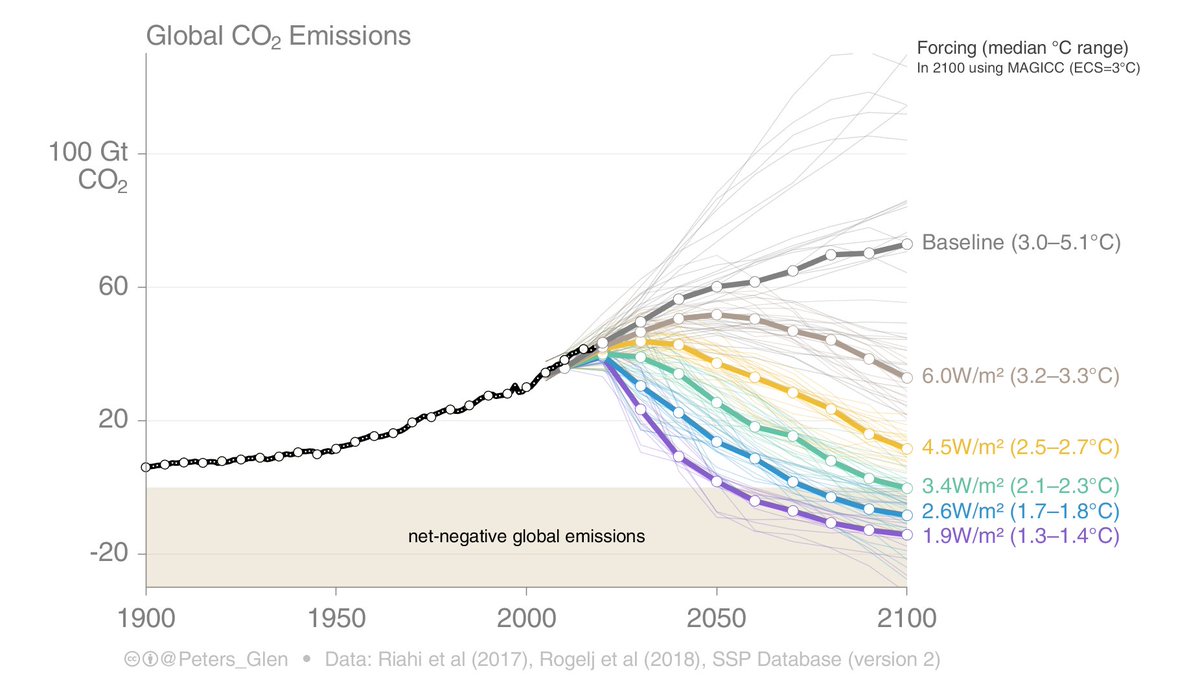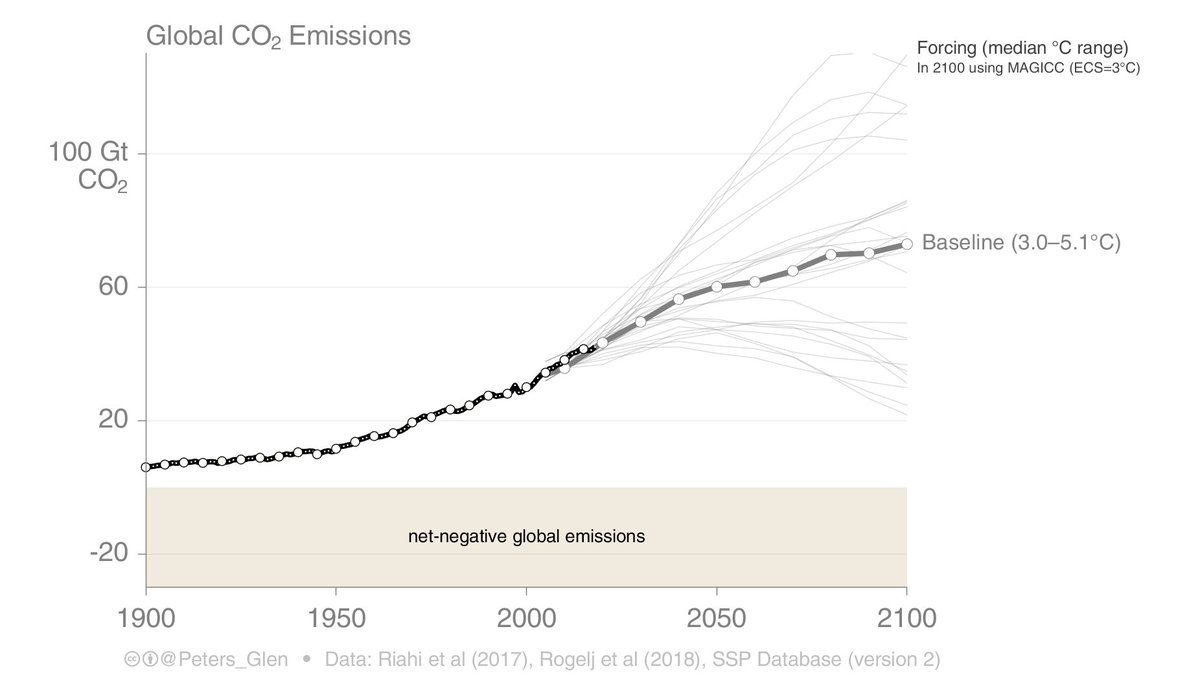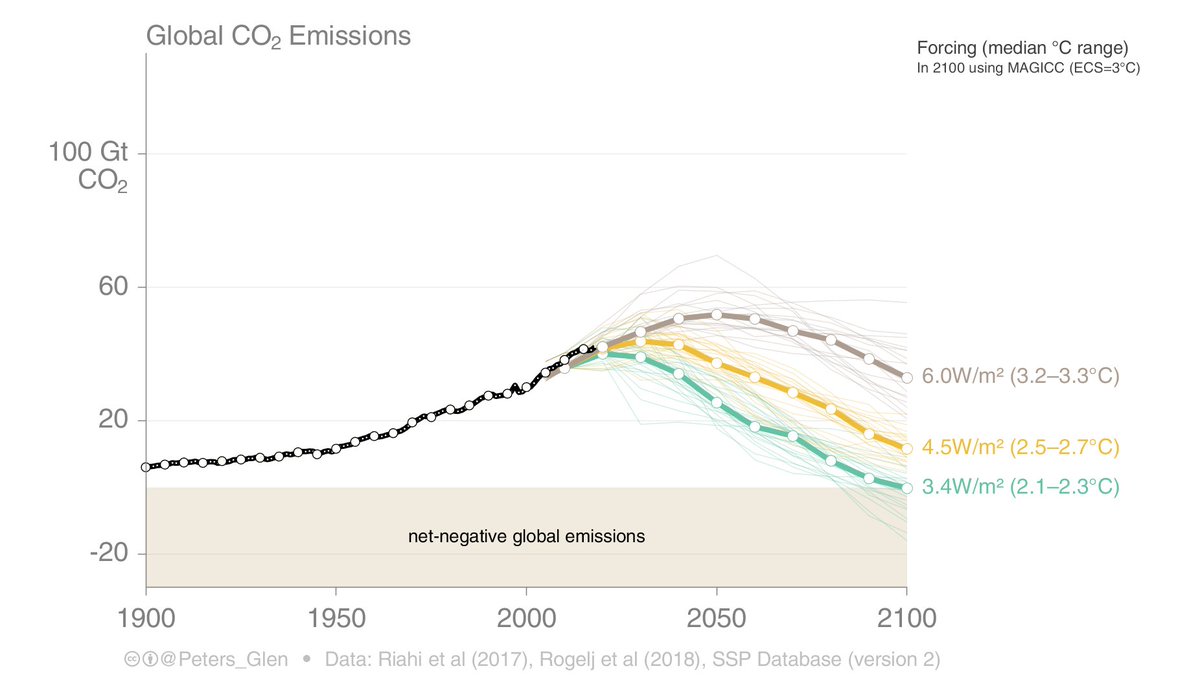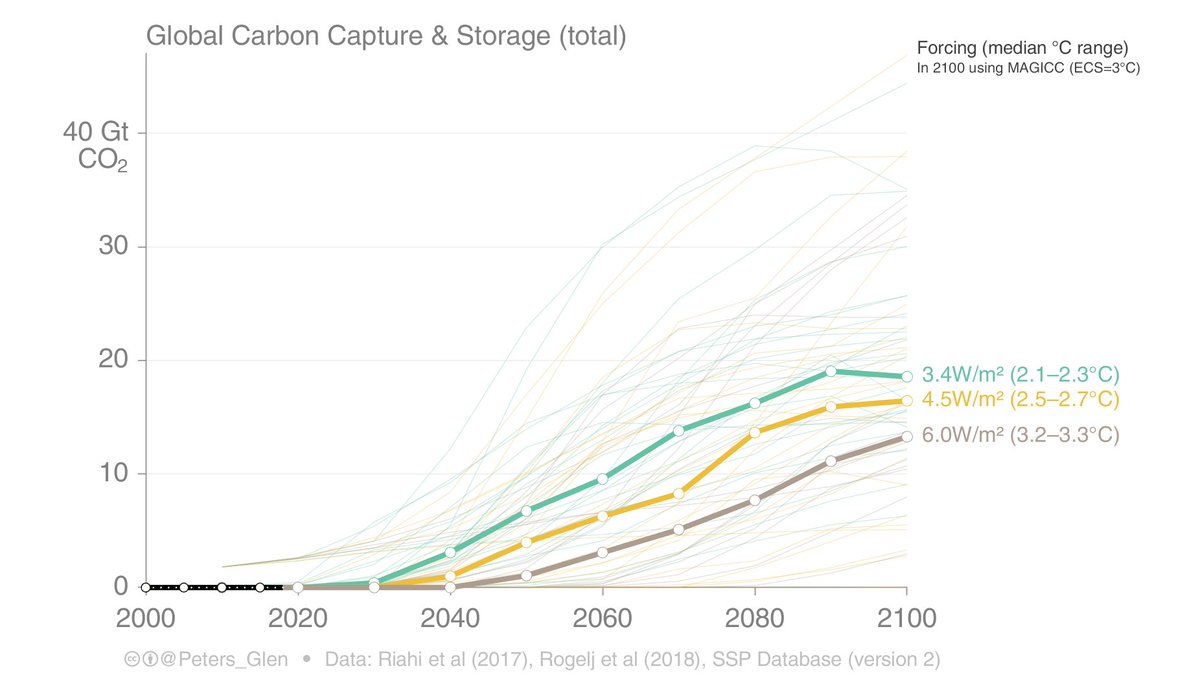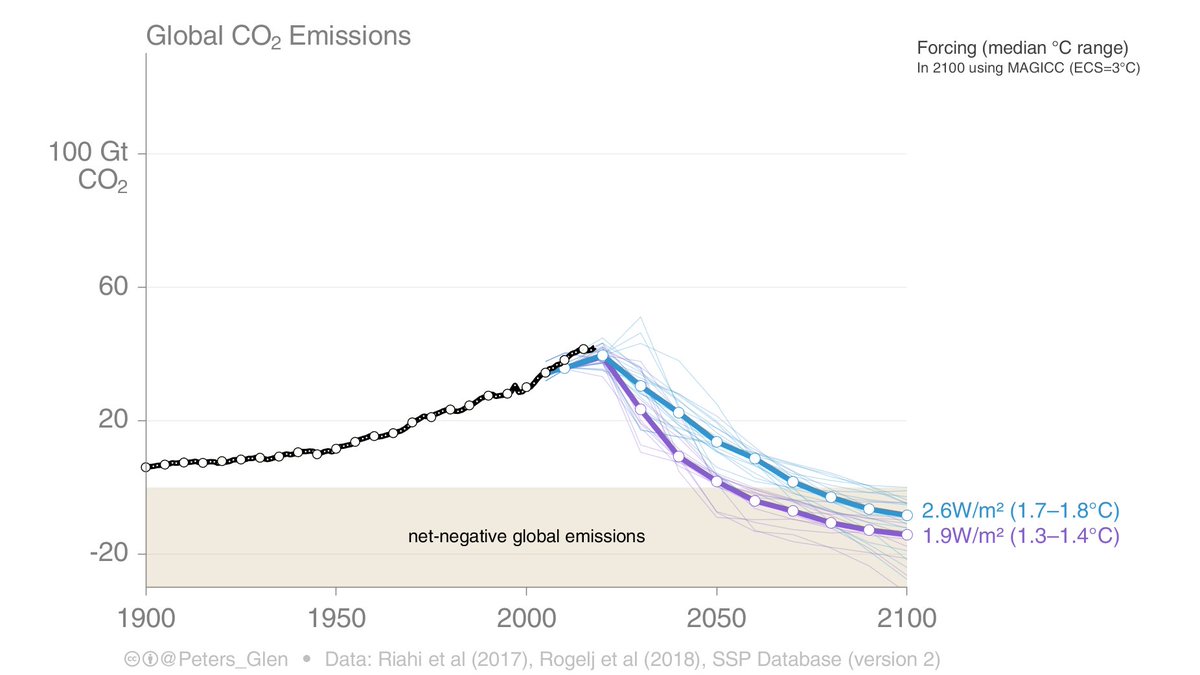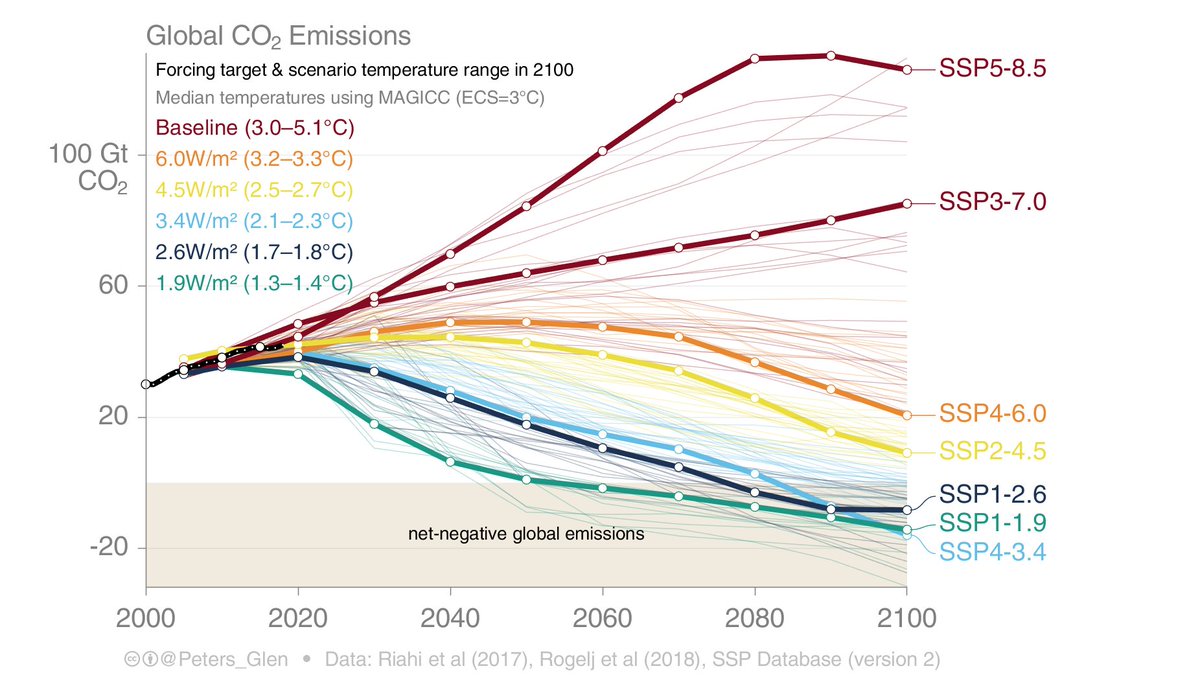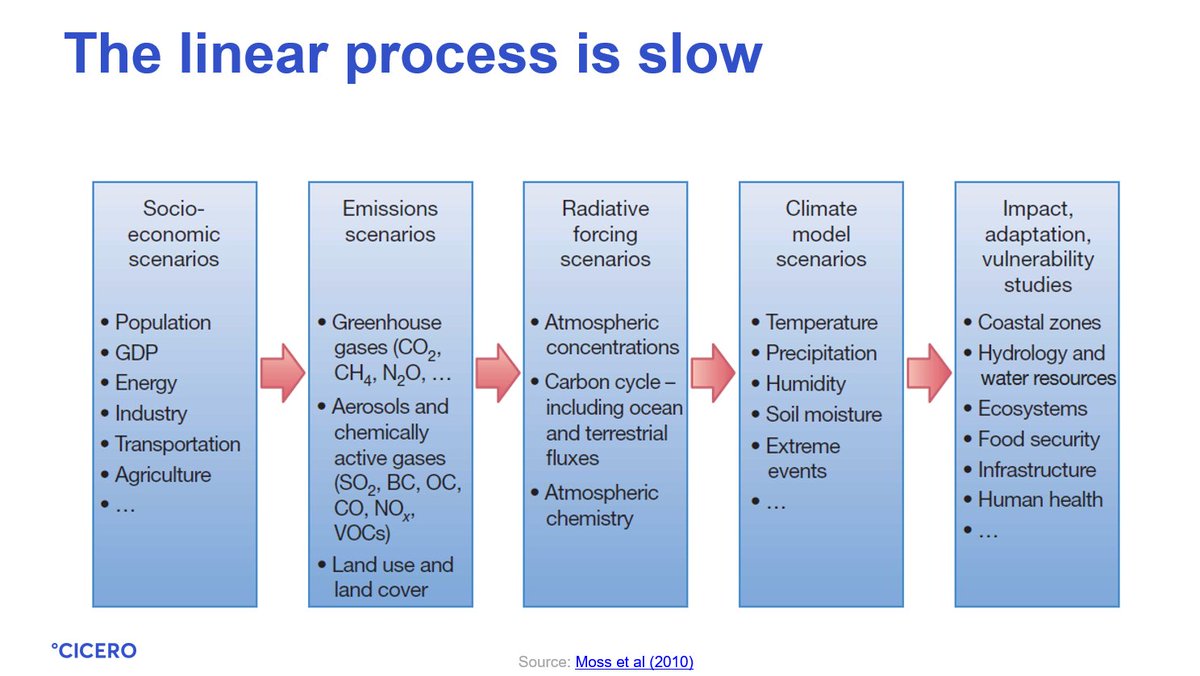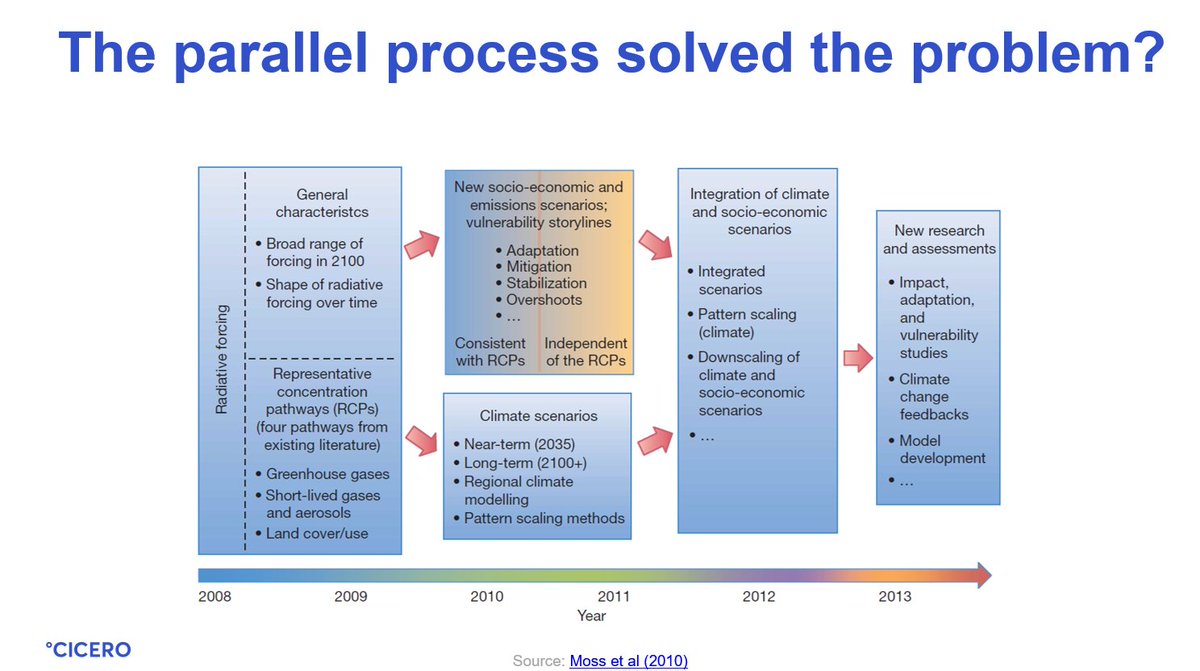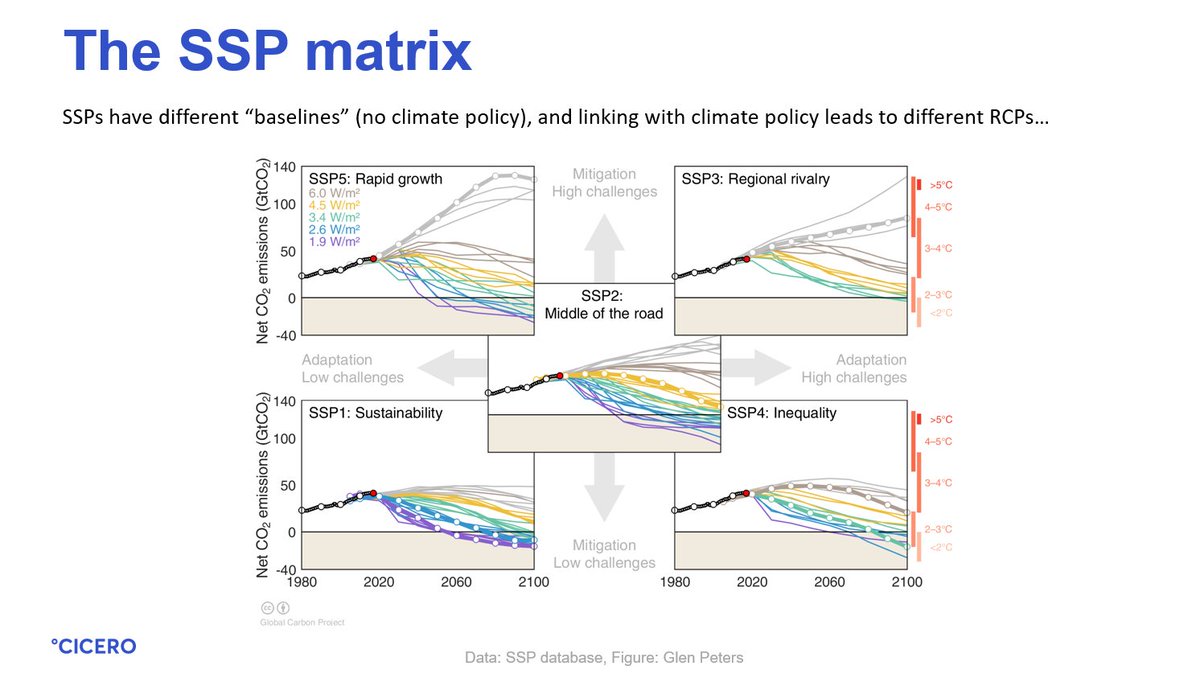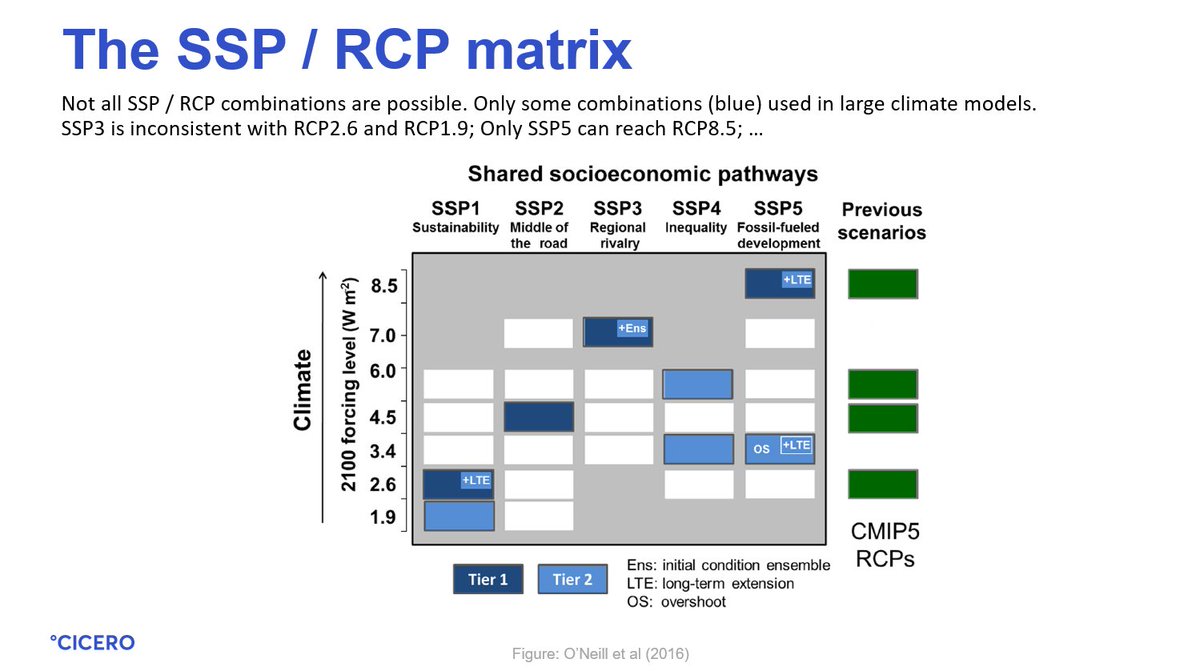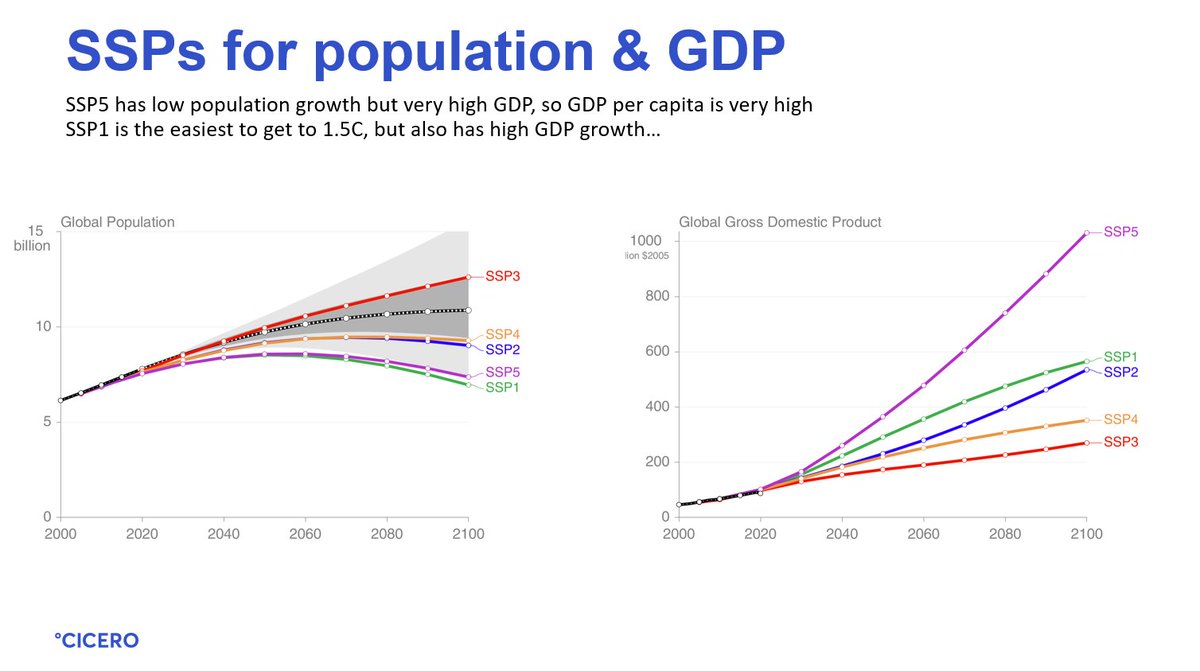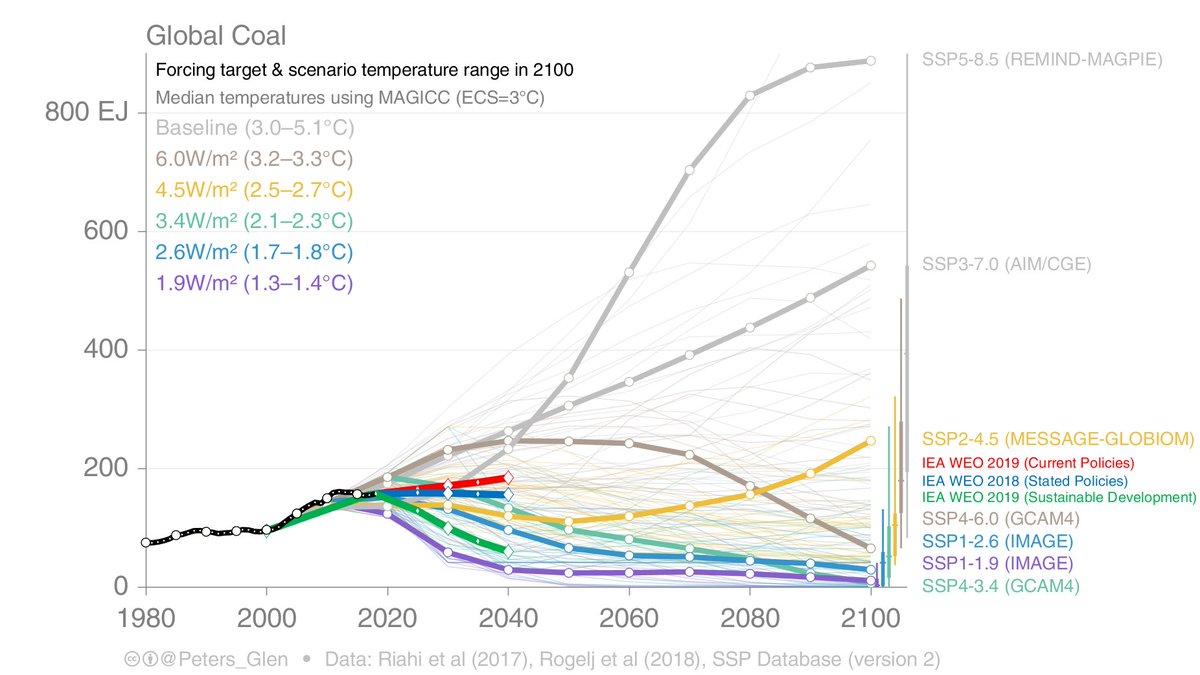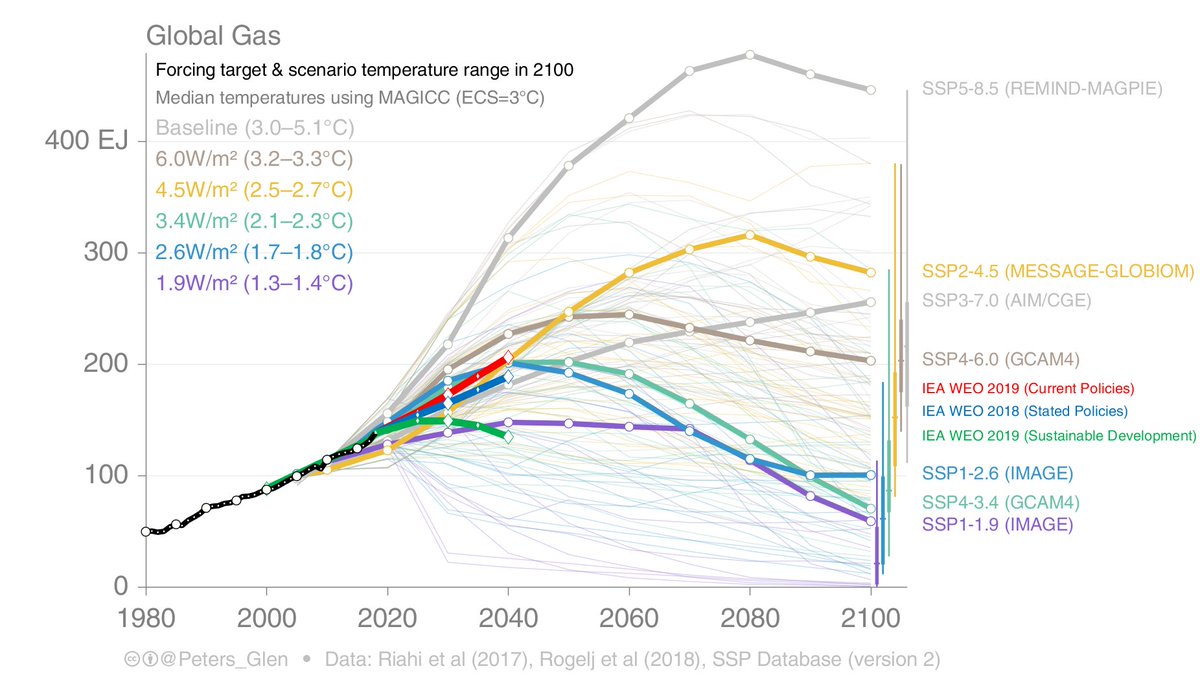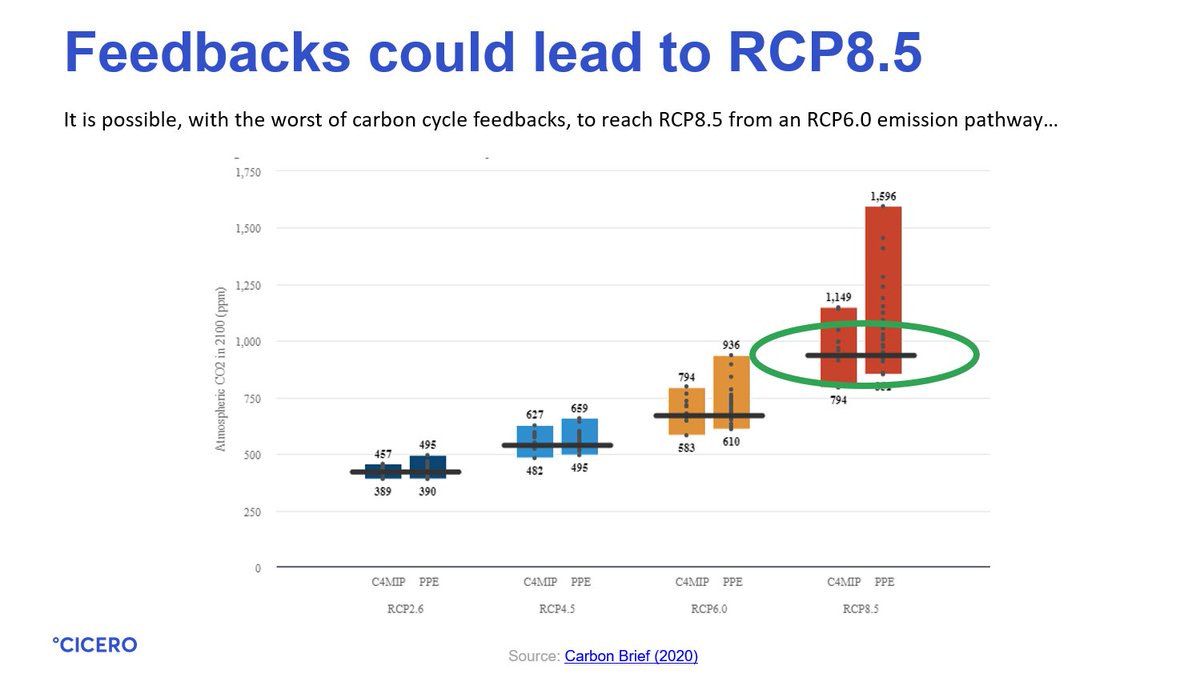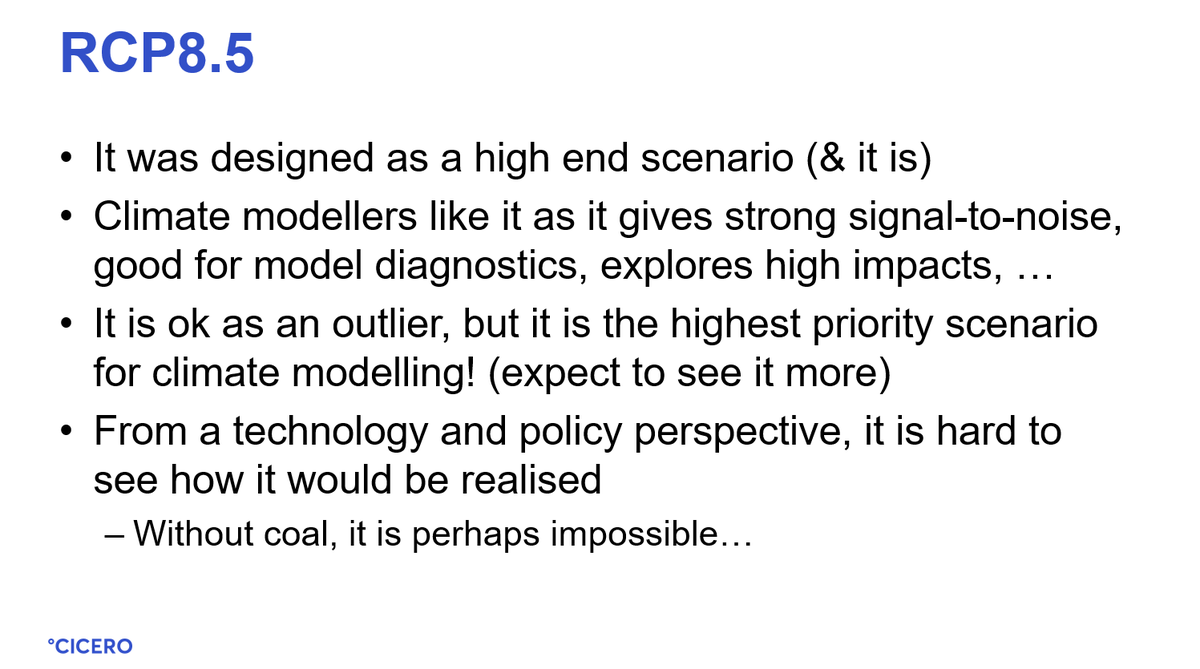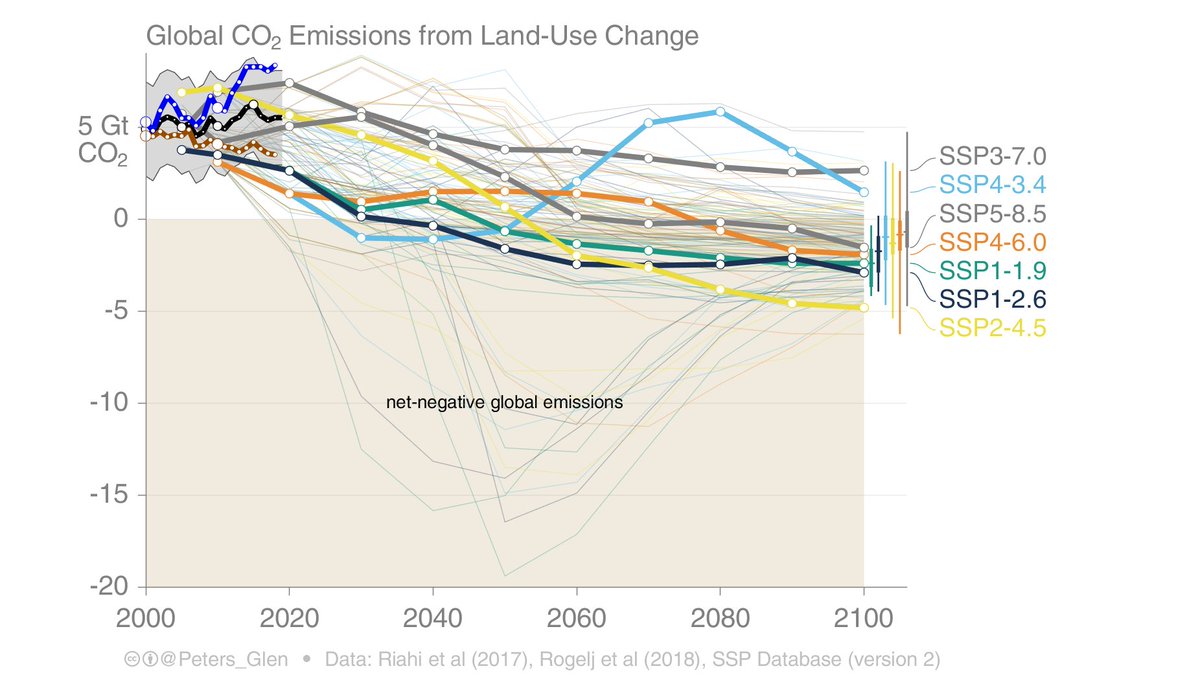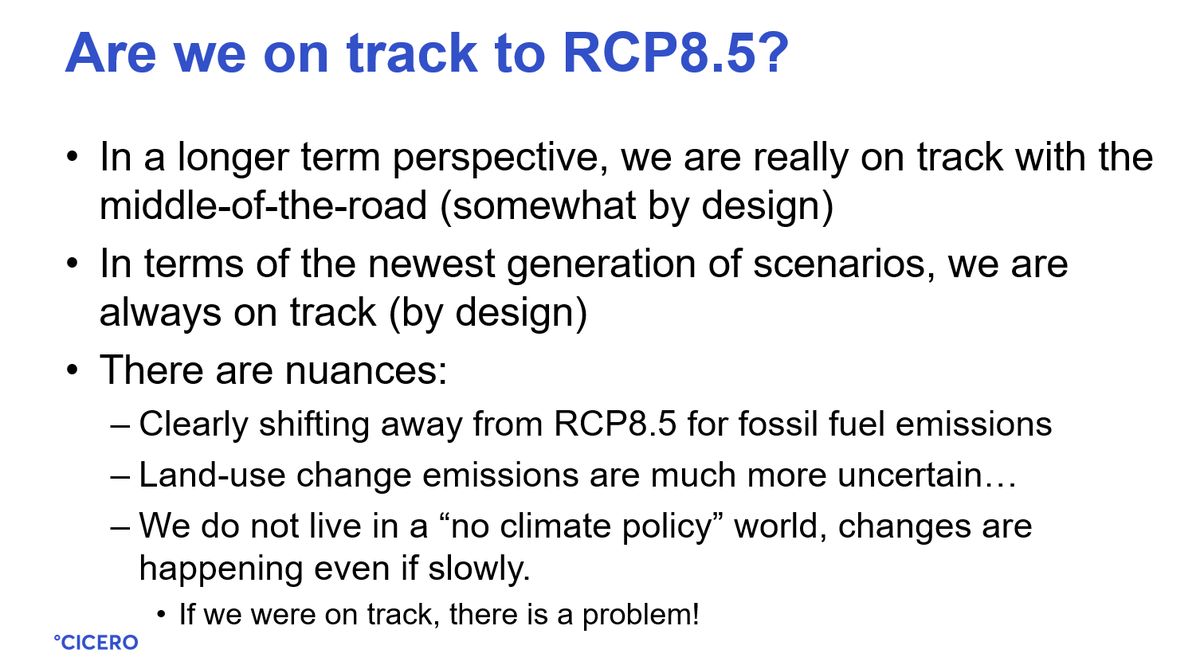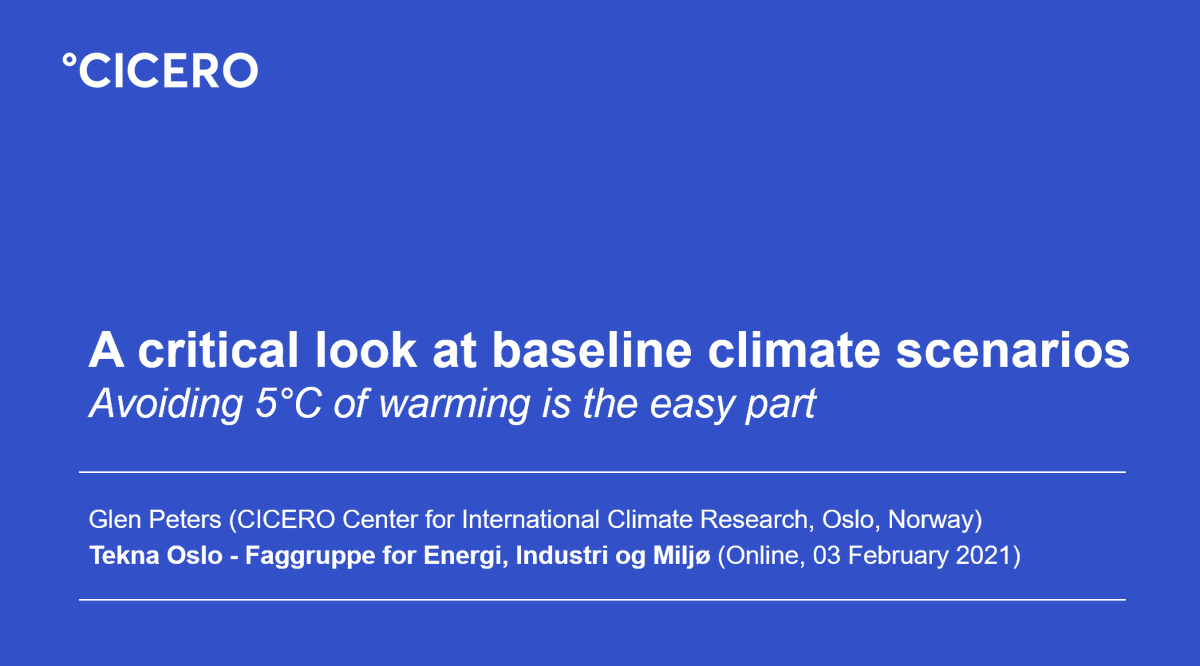THREAD: A critical look at baseline scenarios
I did a presentation for the @Tekna group on Energy, Industry, & Environment.
Presentation: https://www.slideshare.net/GlenPeters_CICERO/a-critical-look-at-baseline-climate-scenarios
Video: https://www.tekna.no/fag-og-nettverk/miljo-og-biovitenskap/bio-og-klimabloggen/a-critical-look-at-baseline-climate-scenarios/
I did a presentation for the @Tekna group on Energy, Industry, & Environment.
Presentation: https://www.slideshare.net/GlenPeters_CICERO/a-critical-look-at-baseline-climate-scenarios
Video: https://www.tekna.no/fag-og-nettverk/miljo-og-biovitenskap/bio-og-klimabloggen/a-critical-look-at-baseline-climate-scenarios/
2. There are a range of scenarios spanning the high-end (>5°C in 2100) to the low-end (<1.5°C in 2100). This shows the Shared Socioeconomic Pathways (one of many scenario intercomparisons).
Out of these scenarios, which ones should be used for analysis?
https://www.carbonbrief.org/explainer-how-shared-socioeconomic-pathways-explore-future-climate-change
Out of these scenarios, which ones should be used for analysis?
https://www.carbonbrief.org/explainer-how-shared-socioeconomic-pathways-explore-future-climate-change
3. Baseline scenarios assume no climate policy. Essentially, integrated assessment models (IAMs) apply no carbon price (or emission constraint).
Baseline scenarios range from emissions peaking & declining (<3°C in2100) to a high-end outlier (by choice) RCP8.5 (>5°C in 2100).
Baseline scenarios range from emissions peaking & declining (<3°C in2100) to a high-end outlier (by choice) RCP8.5 (>5°C in 2100).
4. There are a bunch of middle-of-the-road scenarios which apply climate policy of varying degrees. If CO₂ emissions are not zero in 2100, temperature keeps rising.
In the mitigation literature there is very little analysis of these scenarios.
In the mitigation literature there is very little analysis of these scenarios.
5. BONUS. The middle-of-the-road scenarios are "backcasts", which means the IAM finds the least cost way to the 2100 forcing level.
This means the results are sometimes , such as a huge amount of Carbon Capture & Storage (CCS) if we just muddle through with climate policy.
, such as a huge amount of Carbon Capture & Storage (CCS) if we just muddle through with climate policy.
This means the results are sometimes
 , such as a huge amount of Carbon Capture & Storage (CCS) if we just muddle through with climate policy.
, such as a huge amount of Carbon Capture & Storage (CCS) if we just muddle through with climate policy.
6. Then there are the stringent mitigation scenarios (also "backcasts"). These receive the most attention in the mitigation literature. The IPCC even had a special report on them...
7. There are two many of these scenarios to run through complex climate models (to get climate impacts). A bunch are selected out (shown in bold). More on the labels later.
8. There are different ways to use scenarios.
My view is that it is most interesting to base around where we are heading & look at deviations from that.
* Physical risks explore the climate impacts
* Transition risks explore changes from policy, technology, & society
My view is that it is most interesting to base around where we are heading & look at deviations from that.
* Physical risks explore the climate impacts
* Transition risks explore changes from policy, technology, & society
9. Why are scenarios so complex?
In the old days (say pre-2010), the linear process to develop scenarios was too slow. It took >10 years from scenario design to impact assessment.
https://www.nature.com/articles/nature08823
In the old days (say pre-2010), the linear process to develop scenarios was too slow. It took >10 years from scenario design to impact assessment.
https://www.nature.com/articles/nature08823
10. A parallel process was developed. This selected the "Representative Concentration Pathways" (RCP) first & then climate modelers (climate) & IAMers (emissions) work in parallel.
The merging was meant to be IPCC AR5 (2014).... Not sure it will happen in IPCC AR6 (2021)...
The merging was meant to be IPCC AR5 (2014).... Not sure it will happen in IPCC AR6 (2021)...
11. The SSP framework is theoretically nice, with three orthogonal dimensions (SSP on a grid here, RCP & policy essentially the colours). One can explore implications of socioeconomics in a standardized way.
Each box has a story (assumptions), with variations across boxes.
Each box has a story (assumptions), with variations across boxes.
12. The SSPs also have problems too. There is no unique way to define the boxes.
* Sustainability (SSP1) does not have to be a high growth world, why not degrowth?
* The fossil fuel intensive world (SSP5) is one of the easiest to get to 1.5°C!
* Everyone uses SSP2 any way
* Etc.
* Sustainability (SSP1) does not have to be a high growth world, why not degrowth?
* The fossil fuel intensive world (SSP5) is one of the easiest to get to 1.5°C!
* Everyone uses SSP2 any way
* Etc.
13. The SSP/RCP matrix is a nice way to show how the system works.
Only white boxes have solutions (from IAMs):
* SSP5 is the only one that can do RCP8.5
* SSP1/4 have low baselines
* Only some SSPs for 1.5°C
The blue boxes are scenarios used in CMIP6 by climate modellers.
Only white boxes have solutions (from IAMs):
* SSP5 is the only one that can do RCP8.5
* SSP1/4 have low baselines
* Only some SSPs for 1.5°C
The blue boxes are scenarios used in CMIP6 by climate modellers.
14. Outsiders may be perplexed by some SSP assumptions.
* SSP5 has close to the lowest population, but the highest GDP (very strong growth).
* SSP1 is a high growth world
* SSP3 (Trump world) has high population, but low GDP.
All these are nice features, but one could always
* SSP5 has close to the lowest population, but the highest GDP (very strong growth).
* SSP1 is a high growth world
* SSP3 (Trump world) has high population, but low GDP.
All these are nice features, but one could always

15. SSP5-85 (the new RCP8.5).
We know it is an outlier, by choice. It uses an amazing amount of coal. From 2030 onwards, coal just goes through the roof.
Some argue this is feasible. But...
We know it is an outlier, by choice. It uses an amazing amount of coal. From 2030 onwards, coal just goes through the roof.
Some argue this is feasible. But...
16. The best critique of coal in SSP5-85 is coal per person. It has been flat since 1900 (more or less). SSP5-85 has a unprecedented increase in coal use per person. Even SSP4-70 is a change in trend.
I am not sure we can believe this...
I am not sure we can believe this...
17. Oil use is also extreme in SSP5-85. The drop in oil after 2050 is supposedly replaced by coal-to-liquids. This is one explanation for the high coal growth.
18. Gas is also completely high-end in SSP5-85. Out of all the fuels, this is perhaps most believable?
SSP5-85 has extreme coal, oil, & gas. You really have to work hard to get there. But, coal is key. If you take out coal, then there is no other way to get to SSP5-85.
SSP5-85 has extreme coal, oil, & gas. You really have to work hard to get there. But, coal is key. If you take out coal, then there is no other way to get to SSP5-85.
19. Another way to get to RCP8.5 is to follow emissions like in RCP6.0, but have really bad climate feedbacks (but really bad, not just bad).
This highlights one problem with RCPs, they miss carbon cycle feedbacks, making this question of feedbacks live.
https://www.carbonbrief.org/analysis-how-carbon-cycle-feedbacks-could-make-global-warming-worse
This highlights one problem with RCPs, they miss carbon cycle feedbacks, making this question of feedbacks live.
https://www.carbonbrief.org/analysis-how-carbon-cycle-feedbacks-could-make-global-warming-worse
20. There was perhaps good reason to use RCP8.5 in the day, & there are still reasons to use it (signal-to-noise, model diagnostics, extreme impacts) but these should be flagged for what they are.
The biggest problem is inertia. Modellers will use RCP8.5 for decades...
The biggest problem is inertia. Modellers will use RCP8.5 for decades...
21. Are emissions on track with RCP8.5?
I am guilty here, as one of my papers is often used as a reference... (from 2012) https://rdcu.be/brDGx
I would say we are on track with the middle-of-the-road.
We are not on RCP8.5 for fossil emissions, but LUC makes it complex...
I am guilty here, as one of my papers is often used as a reference... (from 2012) https://rdcu.be/brDGx
I would say we are on track with the middle-of-the-road.
We are not on RCP8.5 for fossil emissions, but LUC makes it complex...
22. Land-use change emissions are extremely uncertain, historical estimates diverge, & scenarios all trend downwards. There has also been some big historical revisions, so the previous figure actually compared inconsistent estimates of LUC (which people don't realise).
23. Are we on track to RCP8.5?
We are on track with the middle-of-the-road. This is somewhat by design.
Each new generation of scenarios is updated with recent trends (see tweet 23 & older scenarios). We are clearly shifting from RCP8.5, but RCP6 is weird so we have a big gap!
We are on track with the middle-of-the-road. This is somewhat by design.
Each new generation of scenarios is updated with recent trends (see tweet 23 & older scenarios). We are clearly shifting from RCP8.5, but RCP6 is weird so we have a big gap!
24. For more discussion of these issues & the way to "well below 2°C" see a comment by @hausfath & myself https://www.nature.com/articles/d41586-020-00177-3
Also see @hausfath @CarbonBrief https://www.carbonbrief.org/explainer-the-high-emissions-rcp8-5-global-warming-scenario
There is of course much more detail to discuss, but...
Also see @hausfath @CarbonBrief https://www.carbonbrief.org/explainer-the-high-emissions-rcp8-5-global-warming-scenario
There is of course much more detail to discuss, but...
25. I must admit. I am over threads. That is like an hour to do 25 tweets... Longer than the presentation...
So, to get the full story, look at the presentation or video...
Presentation: https://www.slideshare.net/GlenPeters_CICERO/a-critical-look-at-baseline-climate-scenarios
Video: https://www.tekna.no/fag-og-nettverk/miljo-og-biovitenskap/bio-og-klimabloggen/a-critical-look-at-baseline-climate-scenarios/
So, to get the full story, look at the presentation or video...
Presentation: https://www.slideshare.net/GlenPeters_CICERO/a-critical-look-at-baseline-climate-scenarios
Video: https://www.tekna.no/fag-og-nettverk/miljo-og-biovitenskap/bio-og-klimabloggen/a-critical-look-at-baseline-climate-scenarios/

 Read on Twitter
Read on Twitter
